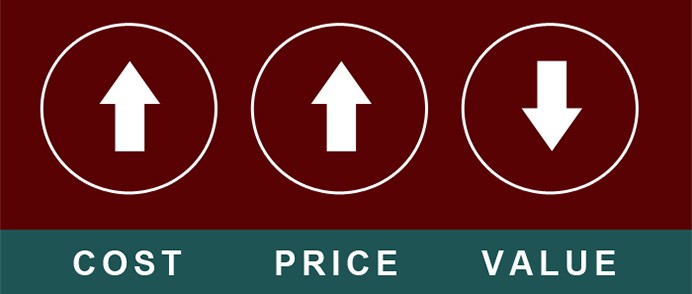Operational Models and Educational Debt in ATS Seminaries
Why do we care? What do we know? What can we do?
A Three-Sided Challenge
Last week, I provided a very broad overview of a research project that focused on operational models and educational debt in Association of Theological Schools (ATS) seminaries. The project was funded by the Lilly Endowment’s Economic Challenges Facing Future Ministers initiative. I co-led the project alongside Harriet Rojas. It was a collaborative effort between Sioux Falls Seminary, Northern Seminary, and Indiana Wesleyan University. When reviewing the data gathered from the project, it seemed that our work and reflections could be divided into three categories. Why do we care? What do we know? What can we do? Today, I begin looking at the first of those three questions: Why do we care?
One of the primary reasons we care is that theological education is facing a three-sided challenge. The three sides of that challenge are cost, price, and value. While I wish I could take credit for this statement, I must confess that it is an adaptation of a concept from Dr. Wright, President of Indiana Wesleyan University. When he first made the statement, he was referring to higher education.
Given the challenges facing theological education and the opportunities created by those challenges, I believe that we can say theological education is facing the same three-sided challenge: cost, price, and value.

Cost
To begin, it costs us too much to deliver theological education. As it is currently structured, our system of theological education is expensive to operate. And it is getting ever more expensive each year. As an industry, over the past two decades our total expenditures have grown at a rate almost three times faster than the rate of inflation. It is even outpacing the changes seen across the rest of higher education. Unfortunately, we have placed the burden of these rising costs on the backs of our students, which leads me to the second component of this three-sided challenge.
Price
As an industry, the price we ask students to pay for theological education is too high. Yes, there are some schools where tuition is free or where tuition is set at a manageable level. Nonetheless, the average cost for a Master of Divinity is roughly $40,000, which is 78% higher than it was in 2001. In later posts, we will see that the price of tuition does not correlate with levels of student debt, which means price is not the primary factor causing student debt. However, price is a factor in how schools calculate the Cost of Attendance (another item to be addressed in later posts). Unfortunately, enrollment is going the opposite direction of the rising price of tuition, which brings us to the third component.
Value
The perceived value of seminaries and the degrees they offer is declining. This decline has been exacerbated by the general decline in the public perception of the North American Church. However, there are always churches that need pastors, nonprofits that need leaders, and business leaders that see their work as ministry. The fact is that the people who once considered seminary to be a place that provided value have begun to question whether or not such value exists.
An Opportunity
This three-sided challenge provides immense opportunity for innovation and change. Theological education is a vital component of the church, and as such we cannot sit idly and let this multifaceted challenge pass us by. Instead, I believe we need to systematically address this challenge from all sides.
Cost can be addressed by reimagining the educational and operational models that, for the most part, haven’t changed for many, many years. By changing cost, we should be able to impact the price. The value proposition for seminaries is probably the one that will take the most work. I believe it is something that is best addressed by a group of seminaries working together, but I will save that for another post.
For the purposes of this post, let me simply say that our value cannot be wrapped up in marketing the incremental changes we make to our existing programs and services. When was the last time we really considered the value we provide? If the answer to, “Why should someone come to seminary?” is “Because we train leaders who have a firm grasp of the Bible,” I suggest we may need to have a more robust (rather than rote) explanation of the value we provide. It seems that our “because” is broken.
Why do we care about operational models and educational debt at ATS seminaries? Perhaps all of what I have written above is best summarized by a quote from Dan Aleshire, Executive Director of ATS. At a gathering of seminary leaders, Dan remarked, “Every future has a history, but every history does not necessarily have a future.” I believe theological education needs to address the three-sided challenge of cost, price, and value so that our history may have a bright future!







